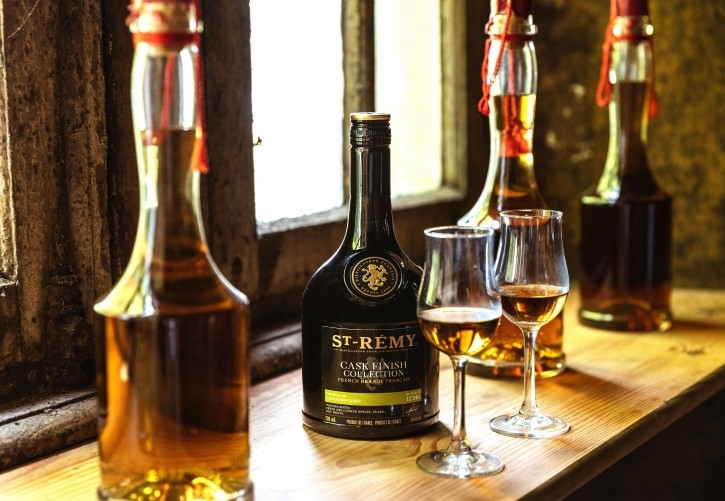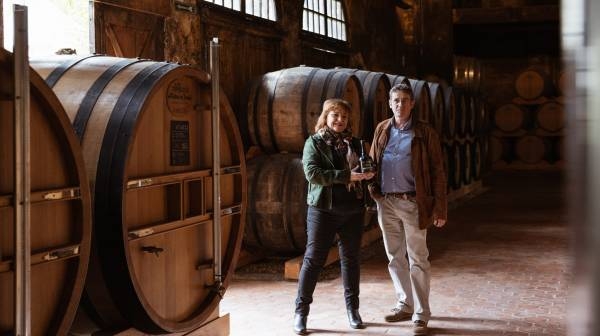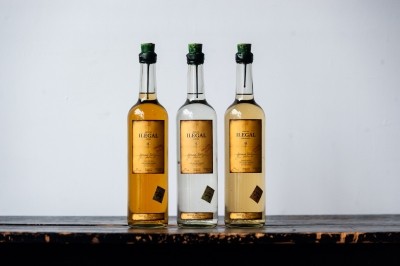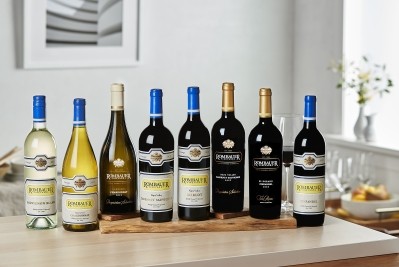From cocktails to calvados casks: How St-Rémy is keeping brandy booming

At St-Rémy, brandy is made from grapes from (and only from) France: which are harvested, pressed, fermented into wine and then distilled into brandy.
That’s why St-Rémy draws so heavily on its ‘100% French’ tagline: because everything from grapes to bottle is indeed actually ‘fabriqué en France’. And that's a key selling point as it grows both at home and abroad.
French craftsmanship
St-Rémy brandy was established in 1886 in the Loire Valley, with Paul-Emile Remy Martin II moving to the region to set up his brandy distillery (at this time, the phylloxera outbreak had damaged the Charente vineyards further south and the vineyards in the Loire Valley offered a surprisingly close equivalent).
Over the next 100 years, the reputation and availability of the brand grew: being exported to 80 countries by 1972.
Today, the portfolio consists of three core products: St-Rémy VSOP (‘delicate and balanced’); St-Rémy XO (‘rich and complex’) and St-Rémy Signature (‘smooth and oaky’).
The character of each brandy draws heavily on the French grapes, which come from all over the country, and each bring certain notes and aromas for Master Blender Cécile Roudaut to play with.
The word ‘brandy’ refers to the eau-de-vie (distillate) from grapes: with the word originating from the old Dutch ‘brandewijn, meaning ‘burnt wine’.
Grapes from Champagne – a cool continental climate where chardonnay and pinot noir thrive in the chalk soils – contribute structure, quince and fresh vegetal notes.
Compare that to the dry, Mediterranean climate of Languedoc Roussillion - where syrah and grenache bring notes of apricot and peach. Meanwhile sauvignon blanc and chenin from the Loire Valley contribute floral flavors and pear notes; while merlot and cabernet sauvignon from Bordeaux’s limestone soils bring a silky and velvety touch with ‘intense plum notes’.
Most challenging for Roudaut is the chardonnay and pinot noir grapes from Burgundy – which bring an intense aromatic pallet of white and exotic fruits – because this smaller region is less prolific and forces her to carefully balance and adjust with a limited supply.
The grapes are harvested, turned into wine, and then distilled according to French traditions. It’s then down to Roudaut to select and blend the eux-de-vie for aging in French oak barrels.
After blending the aged liquid, the brandy is bottled in the Loire Valley and shipped around the world.
'We want to rejuvenate the category'
Like the wine category, brandy faces the challenge of an aging demographic: mainly men between the age of 45 and 60, according to Roudaut. So she’s taken on the challenge of attracting new drinkers to the category.
“We want to rejuvenate the category, with people say 30 years old, and with men and women,” she told us.
With a product that is ‘very smooth, very mellow, no aggressiveness at all’, she believes it can appeal to a far wider audience than it already does.
And the brand is now extolling the role of brandy in cocktails: a category very much on-trend with younger drinkers.
“With St-Rémy I’m very lucky, because it is a well-balanced product with a lot of complexity,” continued Roudaut. “You have floral notes, fruity notes, spicy, woody and this can be easily mixed with fruit juices, soft drinks.”
St-Rémy now promotes, for example, the ‘Bush Ranger’ – a creation from mixologist Matthias Giroud that revisits the Old Fashioned with St-Rémy Signature, Tasmanian pepper artisanal cordial, rhubarb bitter and a eucalyptus leaf.
There’s also a Brandy IPA: a ‘fresh, bitter and fruity’ cocktail with St-Rémy, IPA beer and tropical fruit juice; or the elegant ‘French Garden’: which brings together St-Rémy, apricot liqueur, ginger liqueur and verjus (crab apple cider).
The Cask Collection
The Cask Collection is another example of how Roudaut wants to keep brandy fresh and engaging.
These limited edition series sees Roudaut mature brandy in various types of casks. It started in 2018 with Chardonnay Casks Finish: and has since been followed with Barbados Dark Rum, Islay Scotch Whisky, Cabernet-Sauvignon Casks Finish, Oloroso Sherry Casks Finish, the Sauternes and second batch of Barbados Dark Rum Casks Finish, and Tawny Port.
Now, St-Rémy has just released its latest edition: a collaboration with Château du Breuil, a Calvados producer based in the northern French region of Normandy.
This collaboration, says Roudaut, is special because it is to her a perfect 'marriage': bringing together two French houses with similar traditions and ideals.
There are only 12,850 individually numbered bottles, each featuring Roudaut’s signature.
Matured in barrels that have been previously used in the production of Calvados, the famous French cider spirit, St-Rémy ‘Finished in Calvados Casks’ is described as ‘elegant and mellow, and shows notes of fresh and cooked orchard fruits, vanilla and almonds with a dark yellow color and golden hues.’
The ‘Finished in Calvados Casks’ limited-edition collection from St-Rémy will be distributed in Canada, Taiwan, Poland, France, and Mexico, and in duty-free stores in the UAE, Qatar, Singapore, Australia, and Thailand starting from this month.
So what do these kind of collaborations bring to the brand?
"They permit St-Rémy to touch new consumers, connoisseurs, who want to discover lovely flavors, to have brandy with a different twist on each edition," explained Roudaut.
"With the chardonnay, you have a citrus note; with whisky its peaty notes, with rum its sugar cane, so each time you discover something different. It’s an exploration."
How do you balance tradition and innovation?
The biggest challenge for Roudaut is how to appeal to new drinkers with new exciting innovations while still remaining true to the traditions and values of the 130-year-old St-Rémy brand.
Roudant's career initially started in science – working in both pharmaceuticals and cosmetics – before she studied oenology and joined the wine industry. She came to Remy Cointreau in 1997, working in the R&D department, honing her skills over the next two decades before becoming Master Blender for St-Rémy brandy in 2016.
At the base, her responsibility to balance the flavors of multiple eaux-de-vie from different regions to 'carefully perpetuate the iconic fruity and harmonious style of the core St-Rémy products' year on year.
And yet it’s also about putting her expertise to work in trying new ideas for the brand.
In 2020, ever-innovative, she enthusiastically decided to switch up the French oak barrels used to mature the brandy.
Normally, the brand uses barrels made from querus robur – a large grained barrel. Instead, she decided to try using querus petraea, an oak with a noticeably finer grain that Roudaut was particularly excited about: aiming for coconut and vanilla notes and a cask finish more akin to an American, bourbon style.
So was it a success?
Yes... and no.
“I tried with several barrels and the results were marvellous!” she said. “But I lost the DNA of St-Rémy.”
For a brand rooted in tradition, that was simply not an option.
But, not to be deterred, she then tried a second maturation: this time in the traditional querus robur barrels. This, happily, gave her the balance between old and new that she wanted.
“So this is the birth of St-Rémy Signature: a product with two maturation: the first maturation [with querus petraea barrels] giving youngness, vivacity, vanilla, coconut; and a second maturation process [querus robur] giving the wisdom, structure, spices, cinnamon, candied fruits.
“So this is how I manage innovation and tradition.”










